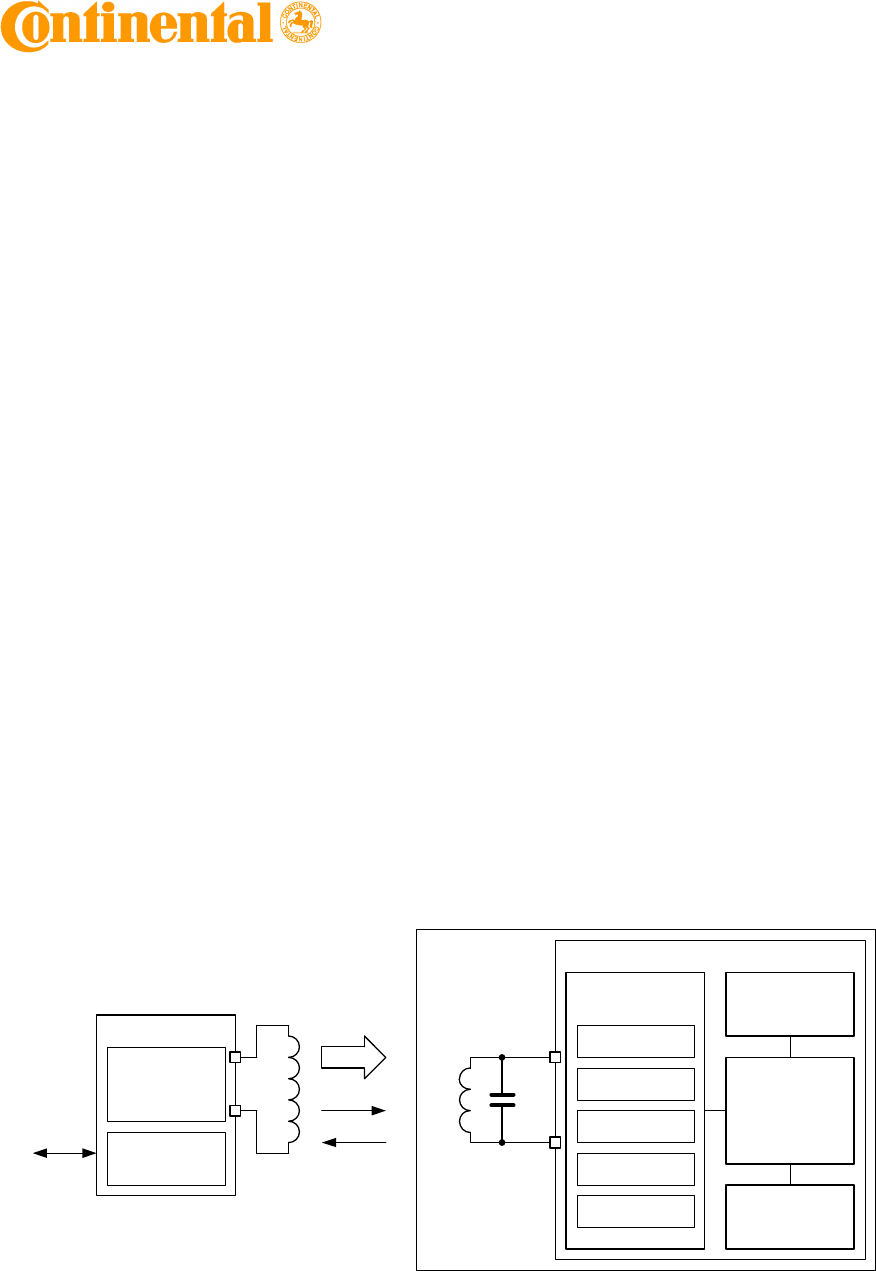Continental Automotive 5NA920791A Immobilizer System User Manual 5NA 920 791 A USA Canadadocx
Continental Automotive GmbH Immobilizer System 5NA 920 791 A USA Canadadocx
user manual

Keller, I ID S3 AD AE CO Page 1 20.10.2016
User manual
Immobilizer System
Type 5NA.920.791.A

Keller, I ID S3 AD AE CO Page 2 20.10.2016
Table of contents
1
System overview ........................................................................................................ 3
2
Transponder ............................................................................................................... 4
3
Power supply .............................................................................................................. 5
4
Technical data ............................................................................................................ 5
5
Label Information ........................................................................................................ 7
USA / Kanada: ............................................................................................................ 7
6
Owner Manual ............................................................................................................ 7
Owner Manual Canada .................................................................................................. 7
Owner Manual USA ....................................................................................................... 8

Keller, I ID S3 AD AE CO Page 3 20.10.2016
1 System overview
The module described within this document is used in the following system environment:
VAG Immobilizer System WFS 5a
The VAG Immobilizer System WFS 5a is, among other things, an integral part of all MQB
instrument clusters.
An immobilizer distinguishes between authorized and unauthorized users and thus it prevents the
engine from running unless the correct key (transponder) is present.
The microcircuit inside the key is activated by a small electromagnetic field which induces current
to flow inside the key body, which in turn broadcasts a unique binary code which is read by the
instrument cluster that includes the immobilizer function. When the cluster determines that the
coded key is both current and valid, the ECU activates the fuel-injection sequence.
The immobilizer is an inductive application (Short Range Device), for this reason a radio approval
(homologation) is required.
All requirements refer to the specification “WFS 5a V1.9 Master” of the Volkswagen AG.

Keller, I ID S3 AD AE CO
Page
4
20.10.2016
2 Transponder
The used transponder (STXP AES) is a read/write RF transponder. It transmits Manchester
coded data to the transceiver by modulating the amplitude of the electromagnetic field and
receives data and commands in a similar way.
The transponder is supplied by carrier of an electromagnetic field induced on the attached coil.
The AC
voltage is rectified in order to provide a DC internal supply voltage. When the DC voltage crosses
the Power-On level, the transponder will enter the Standby Mode and expects commands. In
Standby Mode a continuous sequence of Listen Windows (LIW) is generated. During this time,
the transponder will turn to the Receive Mode (RM) until it receives a valid RM pattern. The
transponder then expects a command to enter the desired mode of operation.
Features:
Battery-less 125 kHz crypt transponder functionality
True 32 bit identifier (Long ID)
Secret-Key in EEPROM (unreadable)
Free User Memory (UM)
Data transmission performed by amplitude modulation
Transmission rate for 125 kHz transponder communication: 4 kbauds
Special protected dataset storage intended for mileage counter
Lock-bits to inhibit programming
Operating temperature range -40 to +85°C
125 kHz field frequency
On chip rectifier and voltage limiter
read
write
Energy
Analog Circuit
Serial Interface
Basestation
LRES B2
EEPROM
1.25 kByte
Control Logic
Calculation
Unit
(Crypto Algorithm)
Contactless Interface
Modulator
Clock Recovery
Demodulator
LF Field
Power On Reset
Rectifier Voltage
Limiter
Security Transponder Chip
L
TXP
C
TXP
Security Transponder
STXP AES
(AES-MEGACRYPT)
f
RES
= 125 kHz (typ.)
Inductive Link
f
SYS
= 125 kHz (typ.)
to µ
µµ
µC
Figure 1: Principle of data transmission between transceiver and transponder

Keller, I ID S3 AD AE CO Page 5 20.10.2016
3 Power supply
Because ANT drivers drive antenna with VDD and VSS power supply levels all variations and
noise in power supply are directly fed to antenna resonant circuit. Any supply voltage fluctuations
or ripple are transferred into antenna current fluctuations by the antenna driver transistors. This is
equal to a current modulation that results in a voltage modulation at the antenna tap point. There
is no possibility for the demodulator to distinguish this modulation from the transponder
modulation (transponder signal superimposed on antenna voltage is in the range of tens of mV).
Especially in the passband of the demodulator filters (<10 kHz), the system is very sensitive
against supply hum and ripple.
For this reason a separate linear voltage regulator is used for the immobilizer circuit. The Enable
pin of this regulator is controlled by the microcontroller. The regulator is only enabled during
transponder communication.
KL30 Voltage for guaranteed immobilizer function and performance:
Minimum Operating Voltage = 6.5V
Nominal Operating Voltage = 13.5V
Maximum Operating Voltage = 17.0V
4 Technical data
Parameter
Symbol
Min
Typ
Max
Unit
Conditions
Supply
Supply Voltage Immobilizer
Module V
KL30
6.5 13.5 17.0 V
Supply Voltage LRES B2 V
DD
4.5 5.0 5.5 V
Current consumption
INHIBIT OFF I
Q
10 µA V
INH
= 0 V;
Full temp. range
Supply current in Sleep
Mode (Quiescent current) I
DDsleep
40 µA Full temp. range
Supply current excluding
drivers current in Normal
Mode I
DDon
5 10 mA
Power on reset level V
por
1.4 3.6 V Full temp. range
AGND level V
AGND
2.35 2.5 2.65 V Full temp. range
µ
µµ
µ
C interface
Input logic high V
IH
0.8 V
DD
V Full temp. range
Input logic low V
IL
0.2 V
DD
V Full temp. range
Input leakage current I
L
-1 +1
µ
A Full temp. range
L/Z_OUT sink current I
L/Z_OUT
2.5 mA
L/Z_OUT output logic low V
L/Z_OUT
0.4 V
Environment requirements
Ambient temperature T
A
-40 +85 °C
Junction temperature T
J
-40 +110 °C
Package thermal resistor R
th
69 70 71 °C/W
Antenna circuit

Keller, I ID S3 AD AE CO Page 6 20.10.2016
Carrier frequency f
ANT
125 kHz
Resonant frequency f
RES
120 125 130 kHz
Antenna voltage V
Coil2
55 75 95 V
pp
L
Coil
= 1.041mH ± 5%,
Q
Coil
= 8.55 ± 15%
Antenna current (RMS) V
sense
30 34 38 mA
L
Coil
= 1.041mH ± 5%,
Q
Coil
= 8.55 ± 15%
Oscillator
Oscillator frequency f
OSC
4 MHz
Antenna drivers
Output resistance R
ADout
3 6 Ω I
A1
=10mA
9 Ω I
A1
=100mA
Full temp. range
AM demodulation
Input sensitivity V
sense
0.85 1.42 mV
pp
Full temp. range
Signal on DEMOD_IN with
no transitions on
DEMOD_OUT
V
SN
140 µV
pp
DEMOD_IN common mode
range
V
CM
V
SS
+ 0.5 V
DD
- 0.5 V
DEMOD_IN input resistance
to AGND R
DI
140 200 260 kΩ
Full temp. range
100 400 kΩ

Keller, I ID S3 AD AE CO Page 7 20.10.2016
5 Label Information
Europa:
Continental
5NA.920.791.A
USA / Kanada:
Continental
Model: 5NA.920.791.A
FCC ID:KR55NA920791A
IC:7812D-5NA920791A
6 Owner Manual
Owner Manual Canada
IC:7812D-
5NA920791A
Operation is subject to the following two conditions:
(1) this device may not cause harmful interference, and (2) this device must accept any
interference received, including interference that may cause undesired operation.
Le présent appareil est conforme aux CNR d'Industrie Canada applicables aux
appareils radio exempts de licence. L'exploitation est autorisée aux deux
conditions suivantes :
(1) l'appareil ne doit pas produire de brouillage, et (2) l'utilisateur de l'appareil doit
accepter tout brouillage radioélectrique subi, même si le brouillage est susceptible
d'en compromettre le fonctionnement.

Keller, I ID S3 AD AE CO Page 8 20.10.2016
Owner Manual USA
FCC ID:KR5
5NA920791A
This device complies with Part 15 of the FCC Rules. Operation is subject
to the following two conditions:
(1) this device may not cause harmful interference, and (2) this device must accept any
interference received, including interference that may cause undesired operation.
Changes or modifications not expressly approved by the party responsible
for compliance could void the user's authority to operate the equipment.